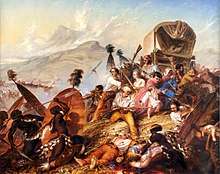Weenen massacre
The Weenen massacre (Afrikaans: Bloukransmoorde) was the Zulu massacre of Khoikhoi, Basuto and Voortrekkers on 17 February 1838. The massacres occurred at Doringkop, Bloukrans River, Moordspruit, Rensburgspruit and other sites around the present day town of Weenen in South Africa's KwaZulu-Natal province.[1]
| Weenen massacre | |
|---|---|
| Part of the Great Trek | |
 Depiction of a Zulu attack on a Boer camp in February 1838. The Weenen Massacre was the massacre of Voortrekkers by the Zulu impis. | |
| Location | Doringkop, Bloukrans River, Moordspruit, Rensburgspruit and other sites around present the day town of Weenen in South Africa |
| Date | 17 February 1838 |
| Deaths | 532 (approx.) |
| Injured | Unknown |
| Perpetrators | Impis of Dingane kaSenzangakhona King of the Zulu |
Massacre
After killing Piet Retief and about 100 people of his delegation, the Zulu King Dingane sent his impis to kill the remaining voortrekkers who were camped at Doringkop, Bloukrans (Blaauwekrans), Moordspruit, Rensburgspruit and other sites along the Bushman River (Zulu: Mtshezi), in the present province of KwaZulu-Natal, South Africa,[1] near the town of Weenen.
"Not a soul was spared. Old men, women and babies were murdered in the most brutal manner." [2]
Death toll
Among the Voortrekkers, 41 men, 56 women and 185 children were killed.[3] In addition another 250[3] or 252[4] Khoikhoi and Basuto that accompanied the Voortrekkers were killed,[5] bringing the casualties to 532–534.
The murdered included George Biggar, the son of Alexander Biggar, a trader at Port Natal. Biggar and his second son, Robert, subsequently participated and died in retaliatory attacks on the Zulus. Most people camped at the Klein- and Groot-Moordspruit were murdered. Here a Boer woman, Johanna van der Merwe, sustained 21 assegai wounds but survived.[1] The camps at Rensburgspruit, where Hans van Rensburg and Andries Pretorius were camped,[1] successfully defended themselves.
Hans van Rensburg's party were compelled to leave their wagons and retreat on foot to a hill, Rensburgkoppie, which was protected by a cliff on one side. Here they were cornered by the Zulus, whom they kept at bay with limited ammunition. When their ammunition was almost exhausted a young man, Marthinus Oosthuizen, arrived on horseback. By shouting instructions they informed him where to locate and salvage ammunition from their camp. This Oosthuizen was able to deliver by charging with his horse through the Zulu file, while covered by the defenders of the hill. With the defense strengthened, the Zulus retreated.[6]
Two months afterwards, on 15 April 1838, Andries Pretorius reflected in his journal: "As we were separated from one another, they succeeded in their attack at daybreak at Blaauwekrans, thereby killing 33 men, 75 women and 123 children."[7] This implies a total of 231 deaths at the Blaauwekrans camps. The name Blaauwekrans (Zulu: Msuluzi) refers to bluish cliff faces present in the area.[1]
Aftermath
The Piet Retief Delegation massacre and the Weenen massacre were the motivation for the Voortrekkers to confront the Zulus in battle on 16 December 1838 when 470 Voortrekkers fought against an estimated 15,000 to 21,000 Zulus; which the Voortrekkers won. The battle is known as the Battle of Blood River.[8]
The town of Weenen (Dutch for "crying" or "weeping")[9] was established in KwaZulu-Natal two months after the massacre.[10]
See also
Notes
- du Plessis, E.J. (1973). Suid-Afrikaanse berg- en riviername. Tafelberg-uitgewers, Cape Town. pp. 204–205, 281, 307. ISBN 0-624-00273-X.
- A. J. P. Opperman, The Battle of Blood River. CUM Books, Roodepoort, 1982. First edition, First impression. ISBN 0 86984 265 X. Page 4
- Theal, George McCall (1886). Boers and Bantu: a history of the wanderings and wars of the emigrant farmers from their leaving the Cape Colony to the overthrow of Dingan. Cape Town: Saul Solomon. p. 106.
- Van der Hoogt, Cornelius W; White, Montagu (1900). "The founding of Natal". The story of the Boers : narrated by their own leaders: prepared under the authority of the South African Republics. New York: Bradley. p. 86. Retrieved 2009-11-28.
- Johnston, Harry Hamilton (1910). Britain across the seas: Africa; a history and description of the British Empire in Africa. London: National Society's Depository. p. 111.
- Carstens, R.; Grobbelaar, P.W. (1988). Voortrekkerlewe. p. 47. ISBN 0-620-12295-1.
- Preller, G.S. (1920–1938). Voortrekkermense VI. Nas. Pers Bpk., Cape Town. p. 8.
- A. J. P. Opperman, The Battle of Blood River. CUM Books, Roodepoort, 1982. First edition, First impression. ISBN 0 86984 265 X. Page 4
- Raper, P.E. (2004). South African Place Names. Jonathan Ball, Jhb & Cape Town. p. 402. ISBN 1-86842-190-2.
- "Weenen". South Africa History Online. Retrieved 15 February 2018.